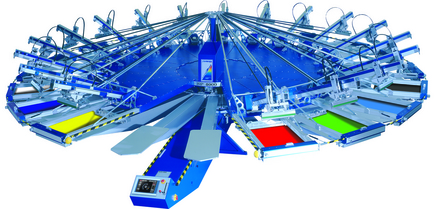Automatic presses bring the production of screen-printed garments to a new level in terms of consistency and output. These machines can crank out simulated-process and multicolor designs, as well as other jobs that would be extremely challenging to complete accurately and profitably on manually operated screen presses. Unfortunately, sluggish setups and awkward adjustments can put a damper on all of the benefits automatic garment presses afford.
MHM developed its Synchroprint 4000 to pull the roadblocks to efficiency that printers often encounter in the front end of the production process and on press. The press is available in two versions, the Synchroprint 4000 AC and Synchroprint 4000 AC Auto-Reg, and offers what MHM describes as the ultimate in sophistication, combining innovative design along with advanced technology and ease of use.
Synchroprint 4000 presses come in six- to 18-color configurations, and each supports a maximum image area of 20 x 28 in. (508 x 711 mm). A large-format image area, measuring 28 x 39 in. (711 x 991 mm), is supported by presses with 14 or fewer colors. MHM reports that the Synchroprint line can produce from 900-1400 pieces/hr, based on press model and assuming single print strokes and medium stroke lengths.
All stations feature control keypads for motorized microregistration, on which six directional keys allow for movements and adjustments as fine as 0.0004 in. (0.01 mm). Each also has a digital information display that shows printhead functions, including screen positions and flood/print speeds. All stations support individual squeegee/floodbar height adjustment, and printheads lift to provide an unobstructed view of the image during setup and ink refill. A squeegee-pressure regulator also is accessible at each station. Other standard features in this area include single-lever angle adjustments in 5° increments (from 0-30°) and quick-release squeegees and floodbars. Loading/unloading stations feature a no-shirt button.
Front and rear stroke-length adjustment is tool- and wire-free. Screen holders are adjustable for front or side loading, and front and rear microregistration comes standard. The Synchroprint 4000 is compatible with Newman roller frames. Centralized off-contact adjustments may be made in 0.04-in. (1-mm) increments during production to minimize press stoppage.
Printheads are engineered with AC drive and linear guidance to deliver smooth and consistent print strokes at all speeds and pressures. Drive belts are fully enclosed and, therefore, shielded from glue, spray, inks, and solvents. Every station has a connection through which flash-cure adjustments may be made remotely from the touchscreen display. It offers finger-tip commands for all main operator functions: individual printhead controls with support for multiple print strokes, plastisol/water-based print modes, sequential print start/finish, sample/test print facility, platen release, dwell timer, platen warm-up, real-time production data, and graphics-assisted self-diagnostics menu. A built-in USB port facilitates online support and software upgrades.
MHM’s GOTO automatic registration system is standard on the Synchroprint 4000 AC Auto-Reg. The operator preregisters pre-registered all screens on the system’s free-standing film-positioning unit. It uses fine-line LED guides to ensures that all film positives are positioned in precisely the same place on all of the screens. All screens are then exposed as usual. Next, the push of a button on the Synchroprint 4000’s touchscreen display executes a reference drive, which ensures that all screen holders on the press start from exactly the same position. The operator then loads all screens into the Synchroprint 4000 in the correct order and switches on any flash-cure units. The primary positive is then placed on the leading platen, checked for placement, and taped down. The operator then moves the leading platen under the first screen by pressing the index button and then pressing up/down to lower the screen on to the platen and artwork. The six directional controls on the printhead’s keypad position the first sscreen only to the artwork. Once complete, a press of the GOTO will cause all of the remaining screens to be driven to the same position.
Options for the Synchroprint 4000 include flash-cure units, aluminum honeycomb platens, squeegees and floodbars, flocking modules, and click-type levered front and rear microregistration—a feature MHM says is ideal when printing thick inks, such as gels and high-density formulations. For more information, contact Hirsch Int’l Corp., 50 Engineers Rd., Hauppauge, NY 11788, 800-394-4426, Web: www.hirschinternational.com.

 Case Studies2 months ago
Case Studies2 months ago
 Art, Ad, or Alchemy2 months ago
Art, Ad, or Alchemy2 months ago
 Andy MacDougall2 months ago
Andy MacDougall2 months ago
 Columns3 weeks ago
Columns3 weeks ago
 Editor's Note2 weeks ago
Editor's Note2 weeks ago
 Marshall Atkinson2 weeks ago
Marshall Atkinson2 weeks ago
 Thomas Trimingham2 months ago
Thomas Trimingham2 months ago
 News & Trends2 months ago
News & Trends2 months ago








